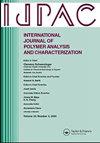Assessment of physical and mechanical and tribological characteristics of poly methyl methacrylate denture based composites doped with nano ceramic particles: a review
IF 1.6
4区 工程技术
Q4 POLYMER SCIENCE
International Journal of Polymer Analysis and Characterization
Pub Date : 2025-06-03
DOI:10.1080/1023666X.2025.2504552
引用次数: 0
Abstract
Poly methyl methacrylate (PMMA) is the most often used acrylic for partial and full dentures. Denture fractures are induced by fatigue as a result of repeated masticatory, flexural, and impact stresses. PMMA’s remarkable qualities, such as beauty, cost-effectiveness, ease of manipulation, low density, and tunable mechanical properties, make it an ideal option for use in dentistry. The durability of pure PMMA is improved by incorporating appropriate weight percentages of nano reinforcement of ceramic material. The doping of nano-reinforcement materials enhances the tensile strength, compressive strength, micro-hardness; flexural strength, yield strength, impact strength, transverse strength, thermal expansion coefficient and decreases water sorption of PMMA composites investigated by different researchers. This study explores how the biopolymer matrix (PMMA) is affected by aluminum oxide (Al2O3), zirconium oxide (ZrO2), and titaniun dioxide (TiO2) reinforcements in terms of mechanical, physical, and tribological characteristics of PMMA dental composites. Additionally, the applications of polymer- based composites are explored.
掺杂纳米陶瓷颗粒的聚甲基丙烯酸甲酯义齿基复合材料的物理力学和摩擦学特性评价
聚甲基丙烯酸甲酯(PMMA)是最常用的丙烯酸树脂用于部分和全口义齿。假牙骨折是由反复咀嚼、弯曲和冲击应力引起的疲劳引起的。PMMA的卓越品质,如美观,成本效益,易于操作,低密度和可调的机械性能,使其成为牙科应用的理想选择。通过加入适当重量百分比的纳米增强陶瓷材料,提高了纯PMMA的耐久性。纳米增强材料的掺杂提高了材料的抗拉强度、抗压强度、显微硬度;不同研究人员对PMMA复合材料的抗弯强度、屈服强度、冲击强度、横向强度、热膨胀系数和减水性进行了研究。本研究探讨了氧化铝(Al2O3)、氧化锆(ZrO2)和二氧化钛(TiO2)增强剂对PMMA牙科复合材料的机械、物理和摩擦学特性的影响。此外,还对聚合物基复合材料的应用进行了探讨。
本文章由计算机程序翻译,如有差异,请以英文原文为准。
求助全文
约1分钟内获得全文
求助全文
来源期刊
CiteScore
3.50
自引率
5.30%
发文量
37
审稿时长
1.6 months
期刊介绍:
The scope of the journal is to publish original contributions and reviews on studies, methodologies, instrumentation, and applications involving the analysis and characterization of polymers and polymeric-based materials, including synthetic polymers, blends, composites, fibers, coatings, supramolecular structures, polysaccharides, and biopolymers. The Journal will accept papers and review articles on the following topics and research areas involving fundamental and applied studies of polymer analysis and characterization:
Characterization and analysis of new and existing polymers and polymeric-based materials.
Design and evaluation of analytical instrumentation and physical testing equipment.
Determination of molecular weight, size, conformation, branching, cross-linking, chemical structure, and sequence distribution.
Using separation, spectroscopic, and scattering techniques.
Surface characterization of polymeric materials.
Measurement of solution and bulk properties and behavior of polymers.
Studies involving structure-property-processing relationships, and polymer aging.
Analysis of oligomeric materials.
Analysis of polymer additives and decomposition products.

 求助内容:
求助内容: 应助结果提醒方式:
应助结果提醒方式:


